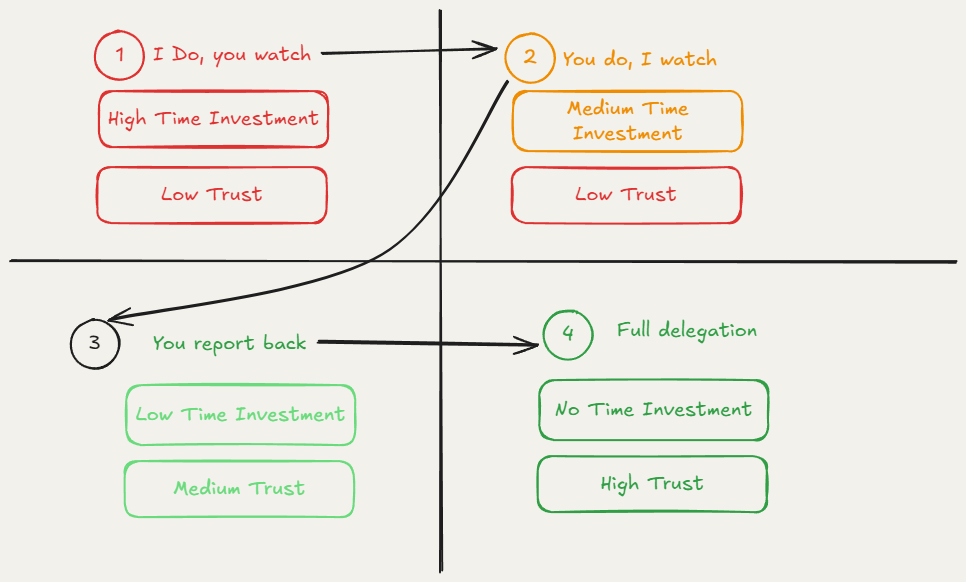Delegation using standards, systems and templates

Delegating work and responsibility can be challenging, especially in complex knowledge work such as software engineering. Often, we don’t have a clear picture of the outcome ourselves, so setting a clear expectation can be difficult. In this post, I outline some of my thoughts on delegation, as well as tools and techniques that have helped me improve my delegation skills.
What is delegation?
Before we get into it, let’s first define delegation. In your role, you have certain responsibilities - duties and tasks that you are accountable for. Delegation involves giving the responsibility of completing a duty or task to someone else. This could be as simple as scheduling a meeting on your behalf or as complex as designing and implementing a large-scale software solution.
The level of work you delegate and how you delegate it depends on the context of the work and who you’re delegating it to. Is it a high-risk or crisis situation where you are not confident it will get done on time or correctly? In such cases, it might be safer not to delegate - either doing it yourself or, better yet, using it as a teaching opportunity by having your team member watch while you do it. However, in most other situations, delegation is always an option if the person you’re delegating to has the necessary ability and capacity. Delegation frees up your time for work that requires your focus and provides a growth opportunity for the individual.
The most important part of delegation is setting a clear expectation of the outcome. However, the more complex the work, the harder it is to do that. Picture this scenario: You need a new table for your house and delegate the responsibility of buying one to someone else. How much information do you provide? For example, the number of people it should seat, the color and materials, the price range - the list goes on. Ultimately, you have to live with the result, so you are likely to provide enough context to ensure you get what you want. This is how you should approach delegating work responsibilities - visualize the desired outcome and articulate it as clearly as possible.
Easier said than done

Articulating your expectations is not always easy. What I’ve come to rely on is a set of levels through which I assign responsibilities.
Level 1 - I do, you watch
As simple as it sounds, you show someone else how to do the work in great detail.
Level 2 - You do, I watch
At this point, you are still very much hands-on in that your full attention is on the work at hand - it’s just not you physically doing it.
Level 3 - Required Reporting
Here’s where delegation really starts to come into play. However, you are typically still in the loop before the “finalization” of the work. Whoever you delegate to is expected to report back to you regularly on progress and on the final result while adhering to the timeline you set.
Level 4 - Full Delegation
At this stage, the individual to whom you are delegating work assumes full responsibility and can complete it with little to no oversight. This person must have a high level of trust and reliability to be given this level of autonomy.
Simplifying the steps
I took inspiration from Standard Operating Procedures (SOPs) typically employed at companies as a foundation for my own delegation tools. SOPs are, in essence, a form of scaled-out delegation - they enable people in an organization to perform certain tasks or duties by following predefined steps.
My approach involves using templates, systems, and standards as a means of guiding others in taking on responsibilities.
- Have some documentation or boilerplate software that needs to be completed? A template outlining how the work should be done is a great way to communicate expectations. It’s even better if you have real-world examples of the template in use.
- Need someone to manage a support process with an external team? Define a system through which they can handle incoming support requests and route them to the correct channels.
- Want someone to help uphold quality standards within the team? Define clear standards so there is no ambiguity about the expectations for quality work.
Tools help, but they don’t cover all cases
While creating these standards, templates, and systems can be incredibly helpful, they are not without flaws. It’s difficult to encapsulate all expectations within these artifacts, but without them, delegation becomes even harder. The key is to iteratively improve them.
If something doesn’t work - whether it wasn’t followed correctly or, even when followed perfectly, didn’t produce the expected result - it’s time to update it!
Get feedback from those you delegate to. Delegation is not a one-way street where you simply assign tasks. Gathering feedback will help refine templates, systems, and standards, ultimately improving your delegation skills.
Delegation is not a blame tool
While you may not be doing the work yourself, you are still ultimately accountable for the outcome. You can’t simply blame (except in extreme circumstances) the individual you delegated work to for a bad result - you were the one who chose to delegate, selected that individual, and set the expectations.
If the task fails, it may be because you delegated at the wrong level or provided insufficient context. Either way, you should see it as a learning opportunity to refine your delegation approach.
Conclusion
Effective delegation is a difficult skill to master, but by using the appropriate level of delegation and creating tools and artifacts to clarify expectations, you can improve this skill and continuously refine it through feedback.
Delegation is the only way to scale your leadership and take on bigger challenges - so grow your team to rise to the challenge with you!